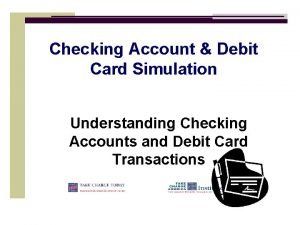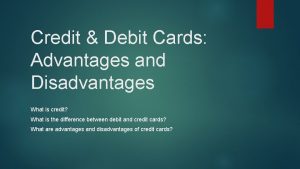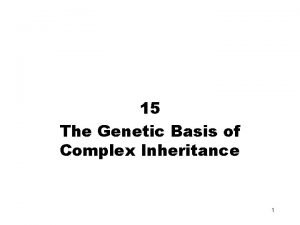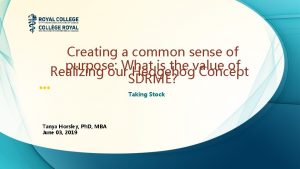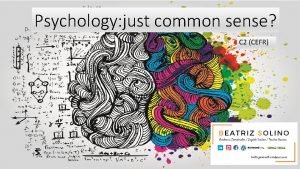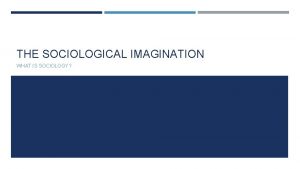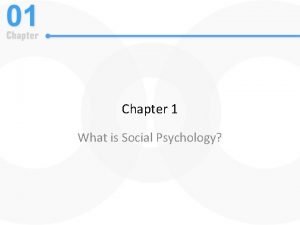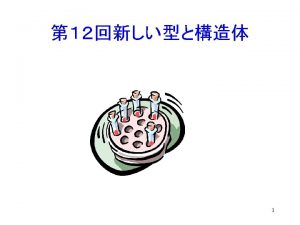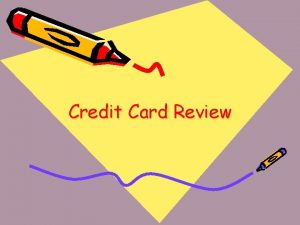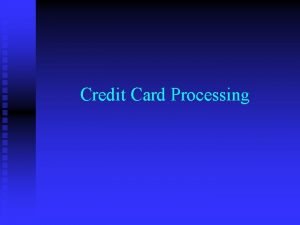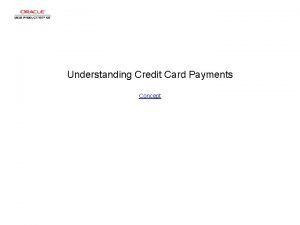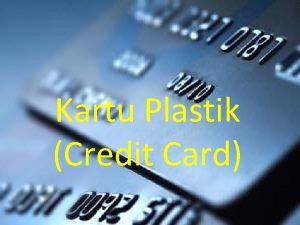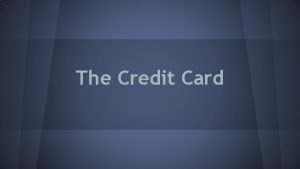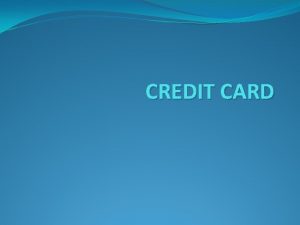Credit Card Common Sense What is a credit











- Slides: 11


Credit Card Common Sense

What is a credit card? Plastic cards that banks and financial institutions grant to cardholders (most credit cards are very easy to obtain, unfortunately) –these cards have information encoded in them that ties them to your credit card account. This information is used by merchants to process purchases and charge them to your credit card account.

Credit vs a Loan Your credit card is tied to a credit account — which is a borrowing tool and a form of debt. But unlike an installment loan, a credit card is a form of revolving credit. This means that instead of borrowing all the money at once like you do with a loan, you borrow as you spend with a credit card. Every time you make a purchase with your credit card, you are doing it with the issuer’s money, not your own. A credit card account will have a limit. This is the maximum amount the credit card company will let you borrow on the account.

Your Balance Any transactions charged to a credit card are added to your credit card balance. This is the amount of money you’ve borrowed by charging purchases to your credit card but have yet to repay. You add to your credit card balance every time you swipe your credit card, and you lower it every time you make a credit card payment.

Minimum Payment Pitfalls • The minimum payment (small compared to overall balance) is the amount you must pay each month to keep your credit card accounts in good standing. Your minimum payment will be due on your credit card due date each month. • A minimum payment is calculated based on your credit card balance. It is usually two to three percent of your credit card balance, or the outstanding interest you owe plus one percent of the balance • https: //www. youtube. com/watch? v=Vz 05 A 6 c. P 6 Iw

A treadmill to nowhere… $2, 000 credit balance with an 18% annual rate, with a minimum payment of 2% of the balance, or $10, whichever is greater, would take 370 months or just over 30 years to pay off. During that time, you would end up paying more $4, 931 in interest and charges, 146% more than the original balance on the card

Interest Fluidity Credit card interest, also called a credit card finance charge, is the cost you pay to have a balance. This is set by your credit card annual percentage rate (APR) which is the rate at which your balance accrues interest. Fixed vs Variable APRs As the terms suggest, variable APRs can fluctuate while fixed APRs usually stay the same. Each credit card company calculates its own annual percentage rate.

Fees and More Fees • You HAVE to understand how to read your credit card terms, statements etc. • -most common is the ANNUAL FEE-the fee you pay simply for having the card… • Balance transfer fees. • Cash advance fees. • Foreign transaction fees. • Late payment fees. • Late payments to one credit card can impact your APR for another card

Types of cards Rewards credit cards Charge cards require borrowers to repay their balances in full every month. So the minimum payment is always equal to the monthly charges on the charge card. Retail cards are credit cards that are issued by a retailer or store, rather than a credit card company or bank. These credit card accounts are with the store itself.

How to Get a Card • Credit score: • 579 and below is poor or bad credit • 580 to 669 is fair or average credit • 670 to 739 is good credit • 740 to 799 is excellent credit • 800 and over is exceptional credit • Credit reports/History/Inquiry • Income: • Understanding the fine print!
 Debit card simulator
Debit card simulator Advantages of debit card
Advantages of debit card Dominant genetic variance
Dominant genetic variance Narrow sense heritability vs broad sense heritability
Narrow sense heritability vs broad sense heritability Common sense of purpose
Common sense of purpose Four factors of fair use common sense
Four factors of fair use common sense Right attitude and common sense
Right attitude and common sense Psychology just common sense
Psychology just common sense Introduction to sociology tischler
Introduction to sociology tischler Sociology vs common sense
Sociology vs common sense Social psychology vs sociology
Social psychology vs sociology Common sense examples
Common sense examples
